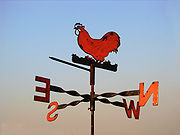
Wind direction
Encyclopedia

Direction (geometry, geography)
Direction is the information contained in the relative position of one point with respect to another point without the distance information. Directions may be either relative to some indicated reference , or absolute according to some previously agreed upon frame of reference Direction is the...
from which it originates. For example, a northerly wind blows from the north to the south. Wind direction is usually reported in cardinal direction
Cardinal direction
The four cardinal directions or cardinal points are the directions of north, east, south, and west, commonly denoted by their initials: N, E, S, W. East and west are at right angles to north and south, with east being in the direction of rotation and west being directly opposite. Intermediate...
s or in azimuth degrees. So, for example, a wind coming from the south is given as 180 degrees; one from the east is 90 degrees.
Origins
Winds are reported as blowing from a direction as the source of a wind is important for the properties of the air that is conveyed ('convected') by the wind. For example, a north wind in Britain frequently brings cooler air, while a 'northeaster' during the winter brings cool, dry air from the north of Europe. For more discussion of this, see Air masses.Other examples of this phenomena are seen worldwide, for example southerly winds into Europe occasionally transport sand from north Africa.
Measurement Methods
There are a variety of instruments used to measure wind direction, such as the windsockWindsock
A windsock is a conical textile tube designed to indicate wind direction and relative wind speed. Windsocks typically are used at airports and at chemical plants where there is risk of gaseous leakage...
and wind vane
Weather vane
A weather vane is an instrument for showing the direction of the wind. They are typically used as an architectural ornament to the highest point of a building....
. Both of these instruments work by moving to minimize air resistance. The way a weather vane is pointed by prevailing winds indicates the direction from which the wind is blowing. The larger opening of a windsock faces the direction that the wind is blowing from; its tail, with the smaller opening, points in the direction the wind is blowing.
Modern instruments used to measure wind speed and direction are called anemometer
Anemometer
An anemometer is a device for measuring wind speed, and is a common weather station instrument. The term is derived from the Greek word anemos, meaning wind, and is used to describe any airspeed measurement instrument used in meteorology or aerodynamics...
s and wind vanes respectively. These types of instruments are used by the wind energy industry, both for wind resource assessment
Wind resource assessment
Wind resource assessment is the process by which wind power developers estimate the future energy production of a wind farm. Accurate wind resource assessments are crucial to the successful development of wind farms.- History :...
and turbine
Turbine
A turbine is a rotary engine that extracts energy from a fluid flow and converts it into useful work.The simplest turbines have one moving part, a rotor assembly, which is a shaft or drum with blades attached. Moving fluid acts on the blades, or the blades react to the flow, so that they move and...
control.
In primitive situations where these modern instruments are not available, a person can use the index finger to test the direction of wind. This would be done by wetting the finger and pointing it upwards. Thus, the side of the finger which feels cool is the direction from which wind is blowing. The coolness is caused by an increased rate of evaporation of the moisture on the finger due to the air flow across the finger, and thus the "finger technique" of measuring wind direction does not work well in either very humid or very hot conditions. The same principle is used to measure the dew point
Dew point
The dew point is the temperature to which a given parcel of humid air must be cooled, at constant barometric pressure, for water vapor to condense into liquid water. The condensed water is called dew when it forms on a solid surface. The dew point is a saturation temperature.The dew point is...
(using a sling psychrometer, a more accurate instrument than the human finger). One may also take a pinch of grass and drop it, the direction that the grass falls is the direction the wind is blowing. You can often see this last technique done by golfers because it allows them to gauge the strength of the wind as well.
See also
- Yamartino methodYamartino methodThe Yamartino method is an algorithm for calculating an approximation to the standard deviation σθ of wind direction θ during a single pass through the incoming data...
for calculating the standard deviation of wind direction - Apparent windApparent windApparent wind is the wind experienced by a moving object.-Definition of apparent wind:The Apparent wind is the wind experienced by an observer in motion and is the relative velocity of the wind in relation to the observer....
- Weather vaneWeather vaneA weather vane is an instrument for showing the direction of the wind. They are typically used as an architectural ornament to the highest point of a building....
- Wind powerWind powerWind power is the conversion of wind energy into a useful form of energy, such as using wind turbines to make electricity, windmills for mechanical power, windpumps for water pumping or drainage, or sails to propel ships....
- Air masses

